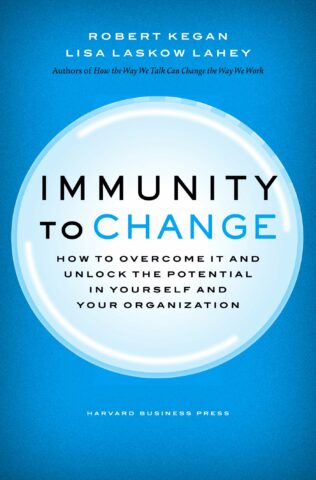4 steps to diagnose your own resistance
Immunity to change is an extremely powerful and wily mechanism. It develops unconsciously to protect us from the dangers involved in changing our habits and ways of thinking, when we step outside our comfort zone. Constructing an “immunity map” – as suggested by Kegan and Lahey – will help you identify and disrupt this mechanism.

Immunity to Change, how to overcome it and unlock the potential in yourself and your Organization, by Robert Kegan and Lisa Laskow Lahey, (Harvard Business Review Press, 2009)
1. Identify your change objectives
The first important step of the immunity map-making process is to pinpoint your objectives. What is the improvement goal that you really need to work on? It’s not about technical improvements, which involve simply learning a new skill, nor about too radical a change, which “would require a total personality transplant,” as the authors put it.
The goal should instead result in personal progress and significant changes for your organization. To be valid, it needs to fulfil several criteria:
– It must be important not just for you, but also for those around you.
– It should depend exclusively on work to be done on yourself.
– The goal must be worded positively in an affirmative sentence. Example: “I want to develop my listening skills.”
If your change goal doesn’t meet the above criteria, it’s pointless to continue. Take time to revise the goal so that it’s compatible with these conditions.
2. List your obstructive behaviors
The second part of the map involves making an uncompromising list of everything you do (or refrain from doing) that runs counter to your change objectives, and which is preventing you from achieving them.
• Try to be as concrete as possible. Be careful to rule out states of mind (such as, “I don’t listen to what I’m told”) in favor of specific behaviors that are observable by the people around you (such as, “I look at my cellphone in the middle of a conversation”).
• The more items you list, the more useful your map will be.
• Don’t hesitate to ask other people to help you complete the list, as this will help you become aware of the behaviors you’ve adopted without even realizing it.
For now, don’t try to explain these behaviors – simply identifying them is enough. Eliminating them, though, is doomed to failure if you don’t understand the motivations that lie behind them.
3. Find underlying motivations
The third step highlights the invisible dynamic: immunity to change. It uncovers the underlying motivations that stand in the way of your goal, and which prevent you from achieving it by justifying obstructive behaviors. This step can be broken down into two stages:
- Fill out your “worry box”
For each item in step 2, ask yourself the following question: “If I picture myself doing the opposite of this, what is the most unpleasant/scary/alarming feeling that will emerge?” For instance, what would happen if you paid attention to the very end of a conversation without checking your cellphone? Would you feel as though you were wasting your time? Are you afraid of missing out on an important piece of information? Would you feel compelled to respond?
- List the possible underlying motivations
The worry box provides the raw material for identifying your underlying motivations. These are unconscious obligations, promises you make yourself to prevent your fears from coming true. For instance, if you’re incapable of saying no, it’s not necessarily out of cowardice. It may be because you want to be liked by people, so you’re committed to not letting them down.
These motivations are all geared towards protecting yourself from something you fear, and justify one or more of your obstructive behaviors.
At this point, you are stuck between two opposing forces: your desire for change and your desire for protection.
4. Face your dangerous assumptions
The final step in this diagnostic process is to trace your way back to the root cause of your immunity by identifying the core beliefs (or assumptions) that underpin your entire mental make-up. The most reliable route to ultimately overcoming your immunity to change begins by isolating the hypotheses and assumptions that sustain it.
These suppositions make up the prism through which you interpret the world. When you start treating a supposition as a truth, it becomes a “dangerous assumption.”
Like behavioral constraints, these assumptions are generally hidden. Bringing them to the surface means taking a look at step 3 and imagining all the underlying assumptions. To find yours, bear in mind the criteria you can use to judge their relevance:
• Each assumption must be proven correct, at least part of the time.
• Each assumption, if taken as true, makes one or more of the constraints in step 3 inevitable. For example: “If it’s absolutely certain I won’t be able to correct a serious mistake, I will do everything I can to avoid making one.”
With your map in hand, you can now understand how these dangerous assumptions reinforce your immunity to change, which will put you in a better position to overcome it, whether individually or as a group.
A word of warning: the solution will require more time and effort than the diagnosis.
© Copyright Business Digest - All rights reserved

© copyright Business Digest, tout droit réservé
